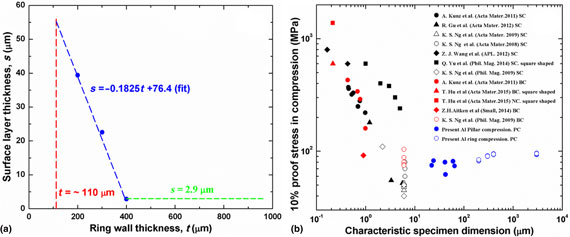Article contents
Mechanical response of mesoscopic aluminum rings under uniaxial compression
Published online by Cambridge University Press: 26 April 2018
Abstract

The strength of materials exhibits size effects at sample dimensions <1 mm. In the literature, two trends are identified in the length scale spectrum: smaller is stronger at <10 µm; larger is stronger at >500 µm. The dimension at which the transition between these two trends occurs remained unclear. We study this mesoscopic scale (20–400 µm) by examining the compression response of ring and pillar-shaped Al specimens. Integrating present results with literature data, we provide Al's compression response in a “master curve” fashion. We demonstrate the inadequacies of the classical surface layer model, and suggest directions for future studies.
Information
- Type
- Research Letters
- Information
- Copyright
- Copyright © Materials Research Society 2018
References
1.Geiger, M., Kleiner, M., Eckstein, R., Tiesler, N., and Engel, U.: Microforming. CIRP Ann. 50, 445 (2001).Google Scholar
2.Fu, M.W. and Chan, W.L.: A review on the state-of-the-art microforming technologies. Int. J. Adv. Manuf. Technol. 67, 2411 (2013).Google Scholar
3.Zabow, G., Koretsky, A.P., and Moreland, J.: Design and fabrication of a micromachined multispectral magnetic resonance imaging agent. J. Micromech. Microeng. 19, 25020 (2009).Google Scholar
4.Zabow, G., Dodd, S., Moreland, J., and Koretsky, A.: Micro-engineered local field control for high-sensitivity multispectral MRI. Nature 453, 1058 (2008).Google Scholar
5.Fleck, N.A., Muller, G.M., Ashby, M.F., and Hutchinson, J.W.: Strain gradient plasticity: theory and experiment. Acta Metall. Mater. 42, 475 (1994).Google Scholar
6.Stölken, J.S. and Evans, A.G.: A microbend test method for measuring the plasticity length scale. Acta Mater. 46, 5109 (1998).Google Scholar
7.Uchic, M.D., Dimiduk, D.M., Florando, J.N., and Nix, W.D.: Sample dimensions influence strength and crystal plasticity. Science 305, 986 (2004).Google Scholar
8.Uchic, M.D., Shade, P.A., and Dimiduk, D.M.: Plasticity of micrometer-scale single crystals in compression. Annu. Rev. Mater. Res. 39, 361 (2009).Google Scholar
9.Engel, U. and Eckstein, R.: Microforming – from basic research to its realization. J. Mater. Process. Technol. 125–126(January), 35 (2002).Google Scholar
10.Chan, W.L., Fu, M.W., and Lu, J.: Experimental and simulation study of deformation behavior in micro-compound extrusion process. Mater. Des. 32, 525 (2011).Google Scholar
11.Chan, W.L., Fu, M.W., Lu, J., and Liu, J.G.: Modeling of grain size effect on micro deformation behavior in micro-forming of pure copper. Mater. Sci. Eng. A 527, 6638 (2010).Google Scholar
12.Zhang, X., Zhang, B., Mu, Y., Shao, S., Wick, C.D.C.D., Ramachandran, B.R., and Meng, W.J.: Mechanical failure of metal/ceramic interfacial regions under shear loading. Acta Mater. 138, 224 (2017).Google Scholar
13.Zhang, B., Song, Y., Voyiadjis, G.Z., and Meng, W.J.: Assessing texture development and mechanical response in microscale reverse extrusion of copper. J. Mater. Res. (2018). DOI: 10.1557/jmr.2018.22.Google Scholar
14.Fu, M.W. and Chan, W.L.: in Micro-Scaled Prod. Dev. via Microforming Deform. Behav. Process. Tool. Its Realiz (Springer London, London, 2014), pp. 9–55.Google Scholar
15.Miyazaki, S., Shibata, K., and Fujita, H.: Effect of specimen thickness on mechanical properties of polycrystalline aggregates with various grain sizes. Acta Metall. 27, 855 (1979).Google Scholar
16.Shen, Y., Yu, H.P., and Ruan, X.Y.: Discussion and prediction on decreasing flow stress scale effect. Trans. Nonferrous Met. Soc. China (Engl. Ed.) 16, 132 (2006).Google Scholar
17.Peng, L., Lai, X., Lee, H.-J., Song, J.-H., and Ni, J.: Analysis of micro/mesoscale sheet forming process with uniform size dependent material constitutive model. Mater. Sci. Eng. A 526, 93 (2009).Google Scholar
18.Peng, L., Liu, F., Ni, J., and Lai, X.: Size effects in thin sheet metal forming and its elastic–plastic constitutive model. Mater. Des. 28, 1731 (2007).Google Scholar
19.Lai, X., Peng, L., Hu, P., Lan, S., and Ni, J.: Material behavior modelling in micro/meso-scale forming process with considering size/scale effects. Comput. Mater. Sci. 43, 1003 (2008).Google Scholar
20.Ng, K.S. and Ngan, A.H.W.: Deformation of micron-sized aluminium bi-crystal pillars. Philos. Mag. 89, 3013 (2009).Google Scholar
21.Ng, K.S. and Ngan, A.H.W.: Effects of trapping dislocations within small crystals on their deformation behavior. Acta Mater. 57, 4902 (2009).Google Scholar
22.Gao, H. and Huang, Y.: Geometrically necessary dislocation and size-dependent plasticity. Scr. Mater. 48, 113 (2003).Google Scholar
23.Ng, K.S. and Ngan, A.H.W.: Stochastic nature of plasticity of aluminum micro-pillars. Acta Mater. 56, 1712 (2008).Google Scholar
24.Kunz, A., Pathak, S., and Greer, J.R.: Size effects in Al nanopillars: single crystalline vs. bicrystalline. Acta Mater. 59, 4416 (2011).Google Scholar
25.Gu, R. and Ngan, A.H.W.: Effects of pre-straining and coating on plastic deformation of aluminum micropillars. Acta Mater. 60, 6102 (2012).Google Scholar
26.Aitken, Z.H., Jang, D., Weinberger, C.R., and Greer, J.R.: Grain boundary sliding in aluminum nano-bi-crystals deformed at room temperature. Small 10, 100 (2014).Google Scholar
27.Wang, Z.-J., Li, Q.-J., Shan, Z.-W., Li, J., Sun, J., and Ma, E.: Sample size effects on the large strain bursts in submicron aluminum pillars. Appl. Phys. Lett. 100, 71906 (2012).Google Scholar
28.Yu, Q., Mishra, R.K., Morris, J.W., and Minor, A.M.: The effect of size on dislocation cell formation and strain hardening in aluminium. Philos. Mag. 94, 2062 (2014).Google Scholar
29.Hu, T., Jiang, L., Yang, H., Ma, K., Topping, T.D., Yee, J., Li, M., Mukherjee, A.K., Schoenung, J.M., and Lavernia, E.J.: Stabilized plasticity in ultrahigh strength, submicron Al crystals. Acta Mater. 94, 46 (2015).Google Scholar
30.Kim, Y., Lee, S., Jeon, J.B., Kim, Y.-J., Lee, B.-J., Oh, S.H., and Han, S.M.: Effect of a high angle grain boundary on deformation behavior of Al nanopillars. Scr. Mater. 107, 5 (2015).Google Scholar
- 5
- Cited by


